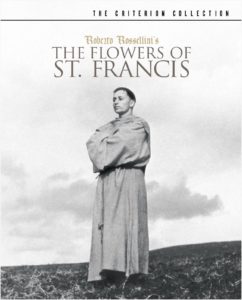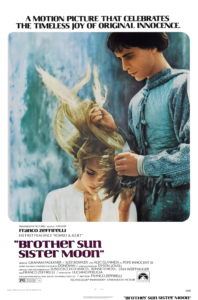I remember a confirmation class some years ago where a well-intentioned teacher asked us to name our favorite saint. She had forgotten that confirmation classes are teeming with teens only there because their parents won’t let them borrow the car otherwise.
The first student arose, racked his head for an interminable few seconds, guessed “St. Francis?” and then slumped back down to safety. The next 29 students copied his answer, save for one kid who said Jesus, his heresy without guile and at least in the spirit of the prompt.
They chose Francis, presumably of Assisi, because he is the saint you know even when you’ve been avoiding saints all your life. He is impossible to dodge: he’s the name of the pope, the statue in the garden, and the stigmatic on your grandma’s kitchen wall. He’s the Captain Planet of the calendar of saints, and the reason your cat scratched you as you were both peppered with holy water. That is the power and tragedy of Francis: he is so popular that he becomes impossible to know.
This ubiquity extends to the arts. The Norton Simon Museum in Pasadena recently ran a film series “Agony and Ecstasy: Saints on Screen,” half of which was dedicated to Francis alone. As fitting the patron saint of Italy, the two films screened were directed by Italian directors, “The Flowers of Saint Francis” (1950), by Roberto Rossellini (and co-written by Federico Fellini), and “Brother Sun, Sister Moon” (1972) by Franco Zeffirelli. (Though I need not have told you they were Italian, with names like that they could hardly be Dutch.)
Despite their shared occupation and nationality, each man takes a different track with Francis, trying to understand a man that was a mystery even to those who knew him best.
Rossellini is an Italian neorealist to the bone and adapts the material to his style, rather than adjust. Like others in the movement he casts nonprofessional actors, this time actual Franciscan monks as St. Francis and his early followers. The monks refused payment, asking only for a firework show at the end of production. Rossellini also employed two priests as consultants on set, though perhaps more for the optics than their input. That he could balance such a holy troupe and his love affair with Ingrid Bergman at the same time is a juggling feat worthy of the greatest “pagliaccio.”
 “The Flowers of Saint Francis” is a spartan affair, set mostly in sparse fields and a single stone hut. Rossellini keeps the film down to earth, with the emphasis on earth. The monks seem to track mud across the film itself. Most Francis films romanticize nature and poverty, with the Franciscans twirling in fields with Terrence Malick-like stupor. But here thorns prick, and bare feet grow numb in pounding rain. Monks serenade nature as always, but we don’t get the impression that nature loves them back. If fire and water are indeed our brother and sister, then it is an estranged family.
“The Flowers of Saint Francis” is a spartan affair, set mostly in sparse fields and a single stone hut. Rossellini keeps the film down to earth, with the emphasis on earth. The monks seem to track mud across the film itself. Most Francis films romanticize nature and poverty, with the Franciscans twirling in fields with Terrence Malick-like stupor. But here thorns prick, and bare feet grow numb in pounding rain. Monks serenade nature as always, but we don’t get the impression that nature loves them back. If fire and water are indeed our brother and sister, then it is an estranged family.
Eschewing a traditional narrative, Rossellini instead compiles nine vignettes of Francis and his followers in action. Occasionally we lose track of the man himself, Rossellini more content to follow Brother Ginepro around on his misadventures. But Francis haunts the picture even when out of the spotlight. Who could inspire such foolishness, and why does the foolishness end up persuading even its harshest critics?
Rossellini was from a proud tradition of lapsed Italian Catholicism where there is no God, but Mary is his mother. He admired without practicing, and you can sense that slight distance in his depiction. He clearly finds the Franciscans a bit ridiculous. But then you also feel that he finds “proper” society even more ridiculous. A healthy man choosing to hug a leper is beyond absurd, yet Rossellini inches closer to recognizing there’s no other choice left.
 Zeffirelli’s “Brother Sun, Sister Moon” is opposite in almost every way, as if in direct response. Perhaps best known for his lavish and frequently freeze framed “Romeo and Juliet” (1968,) Zeffirelli brings his lush eye to the proceedings. In fitting with the title, Francis is in full harmony with nature. We see more flowers in one shot here than in the entire runtime of “The Flowers of Saint Francis.”
Zeffirelli’s “Brother Sun, Sister Moon” is opposite in almost every way, as if in direct response. Perhaps best known for his lavish and frequently freeze framed “Romeo and Juliet” (1968,) Zeffirelli brings his lush eye to the proceedings. In fitting with the title, Francis is in full harmony with nature. We see more flowers in one shot here than in the entire runtime of “The Flowers of Saint Francis.”
Rossellini sees Francis as an enigma, but Zeffirelli whittles him down to something far simpler: a hippie. It’s not the worst interpretation; after all, every century has its 60s. This is Francis as flower child, praising nature, defying authority, and preaching love with a slightly anesthetized glaze about his eyes — and let’s be honest, those haircuts wouldn’t make you blink at a Phish concert. The film is even scored by British folk legend Donovan, if the point hasn’t sufficiently come across. One could argue it’s the most Vatican II film ever put to celluloid.
The film hinges on something of a contradiction. Far more narratively conventional than “The Flowers of Saint Francis,” the film is structured toward Francis’ quest to get sanction from Pope Innocent III (a very good Alec Guinness.) But the film seems to question whether someone who’s so clearly imitating Christ even needs such a blessing. In a nice biblical gesture, the film compromises by the pope kissing Francis’ feet, the last becoming first and the first last. Then the pope is drawn back into his material fold, his servants throwing a regal cloak over him like a fire blanket. One can’t but connect Francis throwing off a similar cloak after his conversion.
The paradox of Francis is he told us precisely who he is: It’s the truth we find incomprehensible. So we’ll continue to struggle and decipher a simple man for another thousand years, forgetting that the only way he is to be understood is if we understand.

